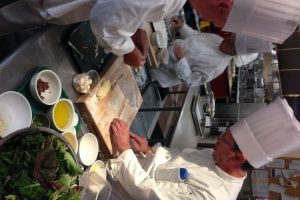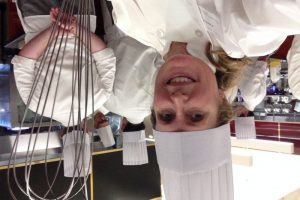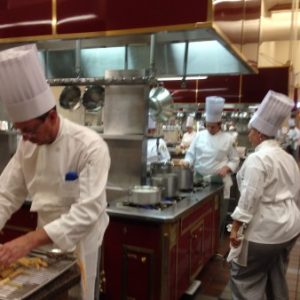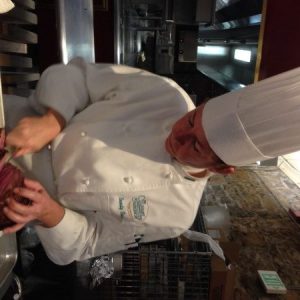
 What does it take to become a Chef?
What does it take to become a Chef?
I arrived for a five-day culinary boot camp at The Culinary Institute of America (aka The “C.I.A.”) Greystone location in St. Helena to find out. Upon check-in, students receive a chef’s uniform consisting of a smart white double-breasted jacket, black & white checkered pants, and the traditional chef’s hat, known as a “toque”. After changing into our uniforms, we went to the classroom to begin our first lecture.
The class started with introductions.
Some students shared that they were already fairly skilled in the kitchen. Other classmates gathered insights from TV shows like “Top Chef” or “America’s Test Kitchen”, or learned how to cook alongside their mothers or grandmothers. And then there were a few whose experience was more limited. The common bond shared is we were ready for culinary adventures!
Foodies and wine enthusiasts from around the world flock here to visit the campus, take a 2-day course, attend a weeklong boot camp, or enroll in the 17-week course to seriously learn how to become a chef. Over 40,000 have graduated from this world’s premier culinary college. In fact, if you walk into most top restaurants, there’s a good chance the chef de cuisine, executive chef, head chef has attended the C.I.A.
Our instructor for the week, Chef Sandy Sauter greeted us and taught us lesson #1:
“Mise-en-place” a French term that means “everything in its place.” She emphasized, “Chefs that follow mise-en-place in the kitchen will maximize efficiency, and it follows them in life.” This concept is all about anticipating what’s coming (the recipe), getting ready & organized (gathering the ingredients), and making sure you’re prepared with an action plan (how to cook in your kitchen). Finally, have an exit plan to get your finished dish from the pot or oven to the table. Top Chefs are mise-en-place experts, and realize the necessity of an orderly kitchen and a carefully planned meal.
During our course, we were exposed to an explosion of flavors, ingredients and dishes. Chef Sauter provided demonstrations, then oversaw us as we developed our skills with hands-on experience.
Highlights from our week at the “Basic Cooking Skills” course:
Monday – Day #1:
Learned about the concept “mise-en-place”, basics for aromatics, stocks, thickening agents and knife skills – slicing, dicing & julienne cutting.
Tuesday – Day #2:
How to sauté, stir-fry, green vegetable & pasta cookery!
Wednesday – Day #3:
Everything you need to know about pan-frying, deep-frying & potato cookery
Thursday – Day #4:
Dry-Heat cooking from grilling, broiling, to roasting! Emulsion sauces and the basic cooking of grains
Friday – Day #5:
Moist-Heat from braising, shallow poaching, deep poaching & steaming and combination cooking
During boot camp week, we learned dozens of lessons & tips including:
- Purpose of a Chef’s uniform – every item is worn for a reason (safety, protection, and hygiene).
- Mise-en-Place Concept – the foundation to becoming a Chef and importance of keeping a kitchen in order.
- Knife Skills – dicing, slicing, julienne, chiffonade, battonet, and how to use knives. Also, never chase a falling knife, just let it go!
- How to debone a chicken
- Difference between stock & broth – how to make and when to use stocks (veal, vegetable, fish, chicken)
- Trust your culinary instincts! How does it taste? Is there a balance of sweet, savory, bitter, spices?
- Basic culinary preparations & aromatics for flavoring like mirepoix vegetable mixture, bouquet garni bunch of fresh herbs, carmelized onions.
- Learning about Pots & Pans & Kitchen equipment
- The “5 Grand Sauces” – what they are, how to make them and when to use them.
- Green Vegetable Cooking – how to blanche and cook your vegetables just right.
- Gluten-Free Overview
- How to make pasta from scratch
- How to tie a roast
- How to cut up a whole salmon
- Learning all about whole grains & how to prepare them – barley, corn, millet, oats, quinoa, rice, rye, wheat, wild rice.
- Dry-Heat Cooking: How to roast, grill, pan-fry, stir-fry & methods. How to make marinades, tenderize, and techniques to grill/mark your meat.
- Moist-Heat Cooking: How to braise, shallow poach, deep poach & steam
- Testing food for doneness, types of thermometers to use, proper temperatures for carryover cooking
- Importance of dish presentation
At the end of each day, our class presented the dishes we made, and then enjoyed a buffet style dinner. Some of the 70+ dishes we created during the week included Veal Saltimbocca, Pasta Linguine, Gnocchi, Grilled Salmon, Ossobucco alla Milanese, 40-Garlic Clove Chicken, Stir-Fried Beef & Veggies, Trout a le Meuniere, Spaetzel, French Onion Soup, Pan Fried Pork Loin, Roast Sirloin of Beef au Jus, Saffron Risotto with peas. And the Sauces that accompanied some of these dishes were exquisite – Beurre Blanc, Bernaise, Remoulade
After a week of instruction, demos, and “real” cooking experience, I survived boot camp and received a “Boot camp Completion Certificate” from Chef Sauter. After a week in the kitchen, we have a growing admiration for Chefs and their staff who work behind the scenes. We have a heightened appreciation when we see a perfectly carved vegetable, or receive a meat dish that is tender, juicy, and cooked just at the right temperature for the right amount of time. Although my career path doesn’t see me wearing a “toque” in the near future, I’m looking forward to applying the knowledge and skills gained from this course. Our class has returned to our own kitchens with more confidence to approach new recipes, and trust our culinary instincts.

The C.I.A. offers several options
From one week boot camps to 3 day training courses like “Basic Cooking Skills” to “Everything Chocolate”, “Artisan Breads at Home”, “Italian Cooking”, “Pies & Tarts”, “Gluten-Free Cooking” and “Gourmet Meals in Minutes”. USA Today calls it one of the “10 Best Cooking School Vacations.” Many of us want to return for more courses and bring a sister, mom, friend, boyfriend, husband. Not only do you go home with a new perspective and renewed passion for cooking, but the courses bring you closer to family and friends. While visiting the C.I.A. campuses, visitors and students enjoy dining at the on-campus restaurants (www.ciarestaurantgroup.com).
Here’s an overview provided by the CIA about the restaurants at the St. Helena location:
Wine Spectator Greystone Restaurant
Presents an innovative menu inspired by the produce and livestock cultivated and harvested from the CIA’s own farms and the fields and farms in the Valley.
The California wine list
Noted for its depth, enhances the fining experience while the bucolic backdrop and spectacular vineyard views set the stage for a rich and satisfying dining experience.
The Conservatory Restaurant
Offers unique dining and an adventure of the senses. CIA culinary students present dishes they’ve mastered from the academic program to diners.
The Bakery Café by illy
Customers can select from a range of sandwiches, soups, salads, breads, pastries, desserts and coffee drinks prepared by CIA students.
Written by: Patricia Stone, a travel writer & consultant Acknowledgements: Global Adventuress would like to thank the C.I.A. (Greystone, St. Helena) Culinary Institute of America for hosting us during our boot camp.
More Information on the CIA
Culinary Institute of America (CIA) is the recognized leader in culinary education for undergraduate students, food service and hospitality professionals, and food and wine enthusiasts. Founded in 1946, the CIA is a not-for-profit college that awards bachelor’s and associate degrees, as well as certificates and professional certification. It is accredited by the prestigious Middle States Commission on Higher Education, and offers consulting services in support of innovation for the food industry.
There are three locations in the U.S.A. – Hyde Park, NY, St. Helena, CA, and San Antonio, TX. www.enthusiasts.ciachef.edu




































Hi Patricia~
Great article!! It was lovely to meet you, and get to spend a deliciously indulgent week in Napa. I LOVED this course, and will be back next year for another…Farm to Table maybe?
XDeirdre
Thanks Deirdre! It was fun to cook alongside you at C.I.A. You’re a natural Chef – your dishes always turned out. Farm to Table sounds like a great course. Will check it out.